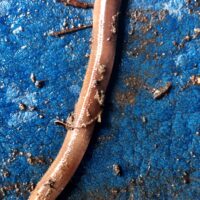 Purdue University - Extension - Forestry and Natural Resources
Purdue University - Extension - Forestry and Natural Resources
Got Nature? Blog
While earthworms in the spring are a happy sight for gardeners, an invasive worm species is wreaking havoc for landowners and gardeners in southern Indiana.
Robert Bruner, Purdue Extension’s exotic forest pest specialist, describes jumping worms, an invasive species to North America in the genus Amynthas: “Traditionally, when we see earthworms, they are deep in the ground and a little slimy. The jumping worms are a little bit bigger, kind of dry and scaly, and tend to thrash around much like a snake does.”
While worms have a reputation as a helpful species found in the soil ecosystem, invasive jumping worms do not live up to that standard, Bruner explained. Jumping worms will consume all organic material from the top layer of soil, leaving behind a coffee ground-like waste with no nutrients for plants or seeds.
Since jumping worms stay within the first few inches of topsoil, they are not creating channels for water and air the way earthworms do, disrupting water flow to plant roots.
“So basically, they’re just very nasty pests that ruin the quality of our soil, and the only thing that can really grow in soil like that are essentially invasive plants, or species that are meant to survive really harsh conditions,” Bruner said.
Currently, the worms are being found in cities around southern Indiana, he said, particularly in Terre Haute. There is still much to learn about jumping worms, making eradication efforts difficult. One thing that is known, Bruner said, is they aren’t a migrating species.
“This is the kind of invasive pest that is moved almost entirely through human activity. They don’t crawl superfast,” he explained. “So, when they move, that means they’re moving because we’re transferring soil, say, from someone’s plants or someone’s compost and we’re bringing them to a new area.”
Any invasive species sightings should be reported to the Indiana Department of Natural Resources at depp@dnr.in.gov or by calling 1-866-663-9684.
For full article with additional photos view: Gardeners asked to be vigilant this spring for invasive jumping worms, Purdue College of Agriculture News.
Other Resources:
Fall webworms: Should you manage them?, Purdue Landscape Report
Mimosa Webworm, The Education Store, Purdue Extension resource center
Sod Webworms, Turf Science at Purdue University
Bagworm caterpillars are out feeding, be ready to spray your trees, Purdue Extension Forestry & Natural Resources (FNR) Got Nature? Blog
Purdue Plant Doctor App Suite, Purdue Extension-Entomology
Landscape & Oranmentals-Bagworms, The Education Store
What are invasive species and why should I care? (How to report invasives.), Purdue Extension – FNR Got Nature? Blog
Indiana Invasive Species Council
Report Invasive Species, Purdue Invasive Species
The GLEDN Phone App – Great Lakes Early Detection Network
EDDMaps – Early Detection and Distribution Mapping System
Indiana Department of Natural Resources: Invasive Species
Indiana Invasive Species Council
Cooperative Invasive Species Management Area (CISMA)
Ask An Expert, Purdue Extension-Forestry & Natural Resources
Jillian Ellison, Agricultural Communication
Purdue College of Agriculture
Bob Bruner, Exotic Forest Pest Educator
Purdue Department of Entomology

Recent Posts
- Smooth Patch of Oak – Purdue Landscape Report
Posted: March 27, 2025 in Forests and Street Trees, Urban Forestry, Wildlife, Woodlands - Prepared for Insects Waking Up? – PLR
Posted: March 26, 2025 in Forestry, Invasive Insects, Urban Forestry, Wildlife - ID That Tree: Invasive Autumn Olive
Posted: March 24, 2025 in Forestry, Invasive Plant Species, Urban Forestry, Wildlife, Woodlands - PPDL’s 2024 Annual Report – Enhancing Plant Health
Posted: March 21, 2025 in Forestry, Invasive Insects, Invasive Plant Species, Plants, Wildlife - Rays Sharing Their Award Winning Forest – Oak Management Forestry Field Day
Posted: March 20, 2025 in Forestry, How To, Invasive Plant Species, Wildlife, Woodlands - New Directory of Professional Foresters Now Available for Indiana Woodland Owners
Posted: March 19, 2025 in Forestry, How To, Woodlands - Planting the Future: Arbor Day Seedlings for Third Graders – IN DNR
Posted: March 18, 2025 in Community Development, Forestry, Woodlands - ID That Tree: Greenbrier
Posted: March 12, 2025 in Forestry, Urban Forestry, Woodland Management Moment - Help the Hellbenders Wins Friends of Conservation Award
Posted: March 7, 2025 in Forestry, Wildlife, Woodlands - Publication – Direct Marketing Guidebook for Small/Medium-Scale Aquaculture Businesses
Posted: in Aquaculture/Fish, Aquatic/Aquaculture Resources, Publication
Archives
Categories
- Alert
- Aquaculture/Fish
- Aquatic/Aquaculture Resources
- Ask the Expert
- Christmas Trees
- Community Development
- Disease
- Drought
- Forestry
- Forests and Street Trees
- Gardening
- Got Nature for Kids
- Great Lakes
- How To
- Invasive Animal Species
- Invasive Insects
- Invasive Plant Species
- Land Use
- Natural Resource Planning
- Nature of Teaching
- Plants
- Podcasts
- Ponds
- Publication
- Safety
- Spiders
- Timber Marketing
- Uncategorized
- Urban Forestry
- Webinar
- Wildlife
- Wood Products/Manufacturing
- Woodland Management Moment
- Woodlands
